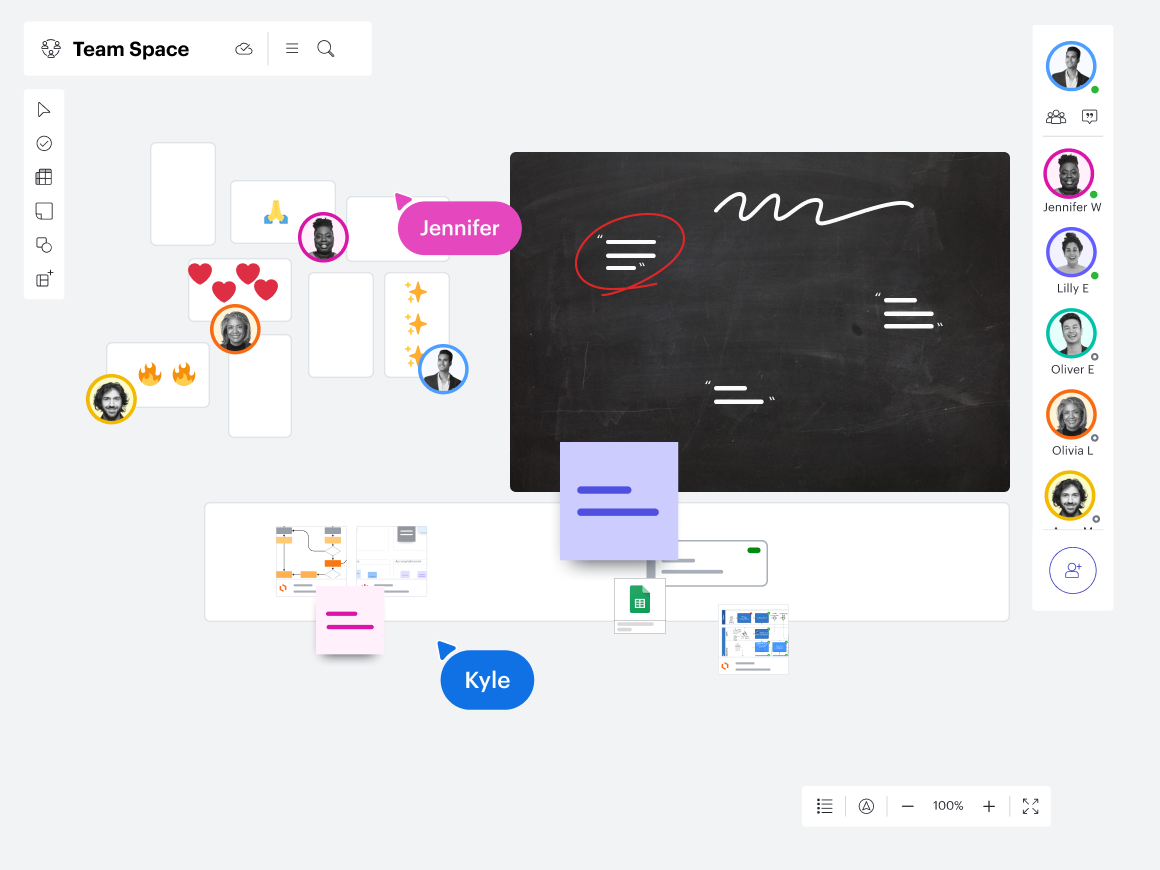
How to turn your document repository into an innovation repository
Reading time: about 7 min
As technology teams seek every avenue to gain an edge over competitors, the concept of innovation is often tossed around as the difference between companies that thrive and companies that don’t. The actual path to innovation in a business context is often murky—and even harder to document.
But documentation is a necessity for innovation. In fact, an effective document repository could separate organizations that innovate by chance from organizations that innovate consistently.
However, not all document repositories will truly help you innovate. Creating a repository that boosts alignment and creativity—what we refer to as an innovation repository—requires an entirely new approach to documentation.
So, how can you transform your document repository from simple file storage into your competitive edge? Let’s dive in.
What is a document repository, and why do you need one?
A document repository refers to the system in which an organization or team stores and centralizes files, including guidelines, process flows, project plans, and more. A centralized document repository is intended to help employees easily and securely find the information they need to do their jobs, make decisions, and innovate.
Despite its obvious value, the mere mention of documentation can be groan-inducing for fast-moving teams. Documentation is often seen as a drag, a chore, an impediment to the thing you’d rather be doing—or the thing you do when you don’t have anything else to do. Accordingly, it’s often done without rigor or regularity, rendering many document repositories out of date, incomplete, and essentially useless.
But documentation can and should be something that’s baked into the way innovative teams ideate, plan, design, build, and launch new products.
This is why teams need to expand their understanding (and acceptance) of documentation beyond dry, impenetrable technical documents by focusing on building an innovation repository.
What is an innovation repository?
An innovation repository represents a new—and arguably much easier—way of creating (and maintaining) a document repository. Unlike traditional approaches that treat documentation as a separate task, an innovation repository can be thought of as an “always on” process. It focuses on turning the work employees are already doing into documentation.
In essence, an innovation repository is constructed of all the documentation that forms a living blueprint of your business.
While most traditional document repositories include basic process or system documentation, an innovation repository takes it a step further. It includes collaborative working sessions, brainstorms, storyboarding, user journeys, process maps, UX wireframes, project timelines, sprint planning boards, cloud architecture diagrams, retrospectives and feedback, launch reviews, and more.

For a document repository to promote innovation, it’s also important that it’s visual and interactive. The visual nature helps show the connections between ideas, clarifies complex concepts, and allows teams to reach a shared understanding. And when a document repository is interactive, teams can collaborate within the repository, centralizing not only documents but also communication—a key to innovation.
In the same way a company wiki serves as a living record of personnel-related procedures, benefits, mission statements, vision decks, and branding guidelines that keep a business running, the goal of an innovation document repository is to capture how ideas come to life, how work gets done, where innovation is happening, and how success is measured and replicated, in order to keep a business innovating.
When ideas can be easily recorded at the point of inception, innovation has a clear trail of crumbs. Done right, your innovation repository shrinks the gap between doing the work and documenting the work to the point where the gap is basically non-existent.

Benefits of creating an innovation repository (over a traditional document repository)
It’s important to note that an innovation repository isn’t a singular piece of documentation but rather a mental model for viewing all the collaborative boards, documents, charts, and plans your teams produce as living, breathing documentation on how your company executes its best ideas.
When done with rigor, this kind of document repository would allow anyone in the business (be it a C-suite exec or a new individual contributor hire) to quickly get informed on how meaningful work is done on a given team or unit, thus eliminating the context gaps and knowledge silos that often hinder seamless collaboration.
For innovation to become the norm, keeping an innovation repository isn’t just a “nice to have” but a requirement to stay competitive and agile.
Turning your document repository into an innovation repository benefits the business because it:
- Acts as a launching pad for change: For organizations undergoing large-scale changes—like a company reorg, digital transformation, cloud expansion, or move to hybrid work—an innovation repository can serve as a holistic “current state” of your company that provides a common starting point for executives. Having a readily available, easy-to-understand record of changes that have already happened, ideas that have been nixed, and bets that have been made allows you to turn your ship with confidence.
- Makes your teams more efficient over time: With a document repository built on a visual canvas like Lucid, you can meticulously track what works and what doesn’t and avoid retreading complex conversations and solving difficult problems you’ve already solved before.
- Reduces learning curves as a result of turnover or growth: For teams that have been forced to reduce their workforce—or for hyper-growth companies that can’t hire fast enough—an innovation repository serves as the ultimate silo buster. By keeping all your best notes, WIPs, and trains of thought in a highly visual shared workspace, your employees can get up to speed, provide value faster, and easily pick up where others left off.
- Democratizes decision-making: Document repositories focused on innovation help meaningful ideas and solutions that actually solve problems win out over office politics and job titles.
The key to creating a document repository that truly boosts innovation
In order to create an innovation repository, you need to collaborate in the right software.
It’s clear that existing tools like email, text chat, and video calls—while useful—are ill-equipped to be the comprehensive tools that distributed teams need to feel aligned, creative, and innovative.
A survey conducted by Lucid found that over a third of knowledge workers cite information lost between meetings as a top barrier to innovation. Without a centralized place to record ideas, notes, or plans, teams lose momentum after meetings and often need to meet again to discuss the same topic.
This is where visual collaboration comes in. Visual collaboration provides teams with a visual language to communicate complex ideas or plans and brings teams together, regardless of location, to collaborate on a shared, infinite canvas.
When teams use a solution for visual collaboration to work together during meetings or asynchronously, they create a clear record of innovation—from the initial brainstorm to the action plan and progress made as they bring ideas to life.

Teams won’t lose information between meetings because they’ve documented the information while collaborating visually during the meeting. They can pick up right where they left off to keep the creativity flowing.
Here’s the best part: The more your organization collaborates with visual collaboration software, the more valuable documentation you create. And the more valuable documentation you have, the more you can innovate.
This is why emerging visual collaboration solutions must go beyond brainstorming or communication. To make innovation predictable and repeatable, visual collaboration must span across the entire lifecycle of work: ideation, planning, designing, building, launching, and monitoring.
When all work is centralized in the same platform, you can create an innovation document repository that serves as a holistic blueprint for how your business functions, grows, and creates value.

10 templates for creating an innovation repository
Get the toolkitUsing a document repository to make innovation the norm
Innovation without documentation is like publishing a cookbook with a list of ingredients but no recipe. To be truly valuable, your document repository must be something that’s easy to understand and embedded in the places, platforms, boards, and planning documents where your teams are already doing their work.
It must paint a clear picture of not only what innovation your team produced but also how it came to life—from ideation and planning to execution at scale.
With a visual collaboration solution like Lucid, documenting the work can become second nature to doing the work. By fostering an intuitive way of working—keeping the work in a single place to make your teams more effective, productive, and efficient—you can start to view innovation as a daily occurrence on their journey to see and build the future.

Ready to get started?
Learn how to centralize your documentation within a single source of truth your team will actually use.
Get the step-by-step guideAbout Lucid
Lucid Software is the leader in visual collaboration and work acceleration, helping teams see and build the future by turning ideas into reality. Its products include the Lucid Visual Collaboration Suite (Lucidchart and Lucidspark) and airfocus. The Lucid Visual Collaboration Suite, combined with powerful accelerators for business agility, cloud, and process transformation, empowers organizations to streamline work, foster alignment, and drive business transformation at scale. airfocus, an AI-powered product management and roadmapping platform, extends these capabilities by helping teams prioritize work, define product strategy, and align execution with business goals. The most used work acceleration platform by the Fortune 500, Lucid's solutions are trusted by more than 100 million users across enterprises worldwide, including Google, GE, and NBC Universal. Lucid partners with leaders such as Google, Atlassian, and Microsoft, and has received numerous awards for its products, growth, and workplace culture.
Related articles
Guide: How to use an innovation framework to turn ideas into action
Don't leave innovation up to chance. Learn how to use Lucid’s innovation framework to make innovation a repeatable, scalable occurrence.
Busting 5 common innovation myths with GIANT Innovation’s David Dabscheck
Innovation is on everyone’s minds—but what does it really mean to be innovative? Find out in this myth-busting article with GIANT Innovation’s David Dabscheck.
4 reasons modern organizations need internal documentation
The purpose of internal documentation is to centralize an organization’s ideas and information and make them accessible throughout the organization.
How Lucid boosts innovation—from ideation and beyond
Discover how Lucid enhances your innovation process from ideation to reality.
